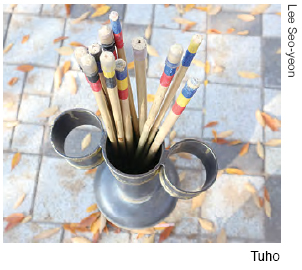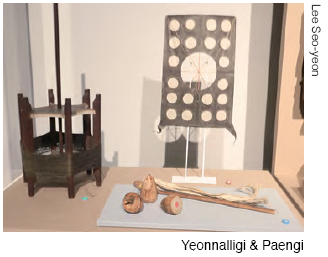A Netflix Original Series, “Squid Game,” has made various Korean games popular all over the world. However, there are other traditional Korean games that have not received much attention from both foreigners and Koreans alike. Therefore, in this article, The UOS Times introduces some of the captivating traditional Korean games that were not dealt with in “Squid Game.”
Yut-nori

Yut-nori is a traditional Korean board game in which more than two teams compete. Each team has four pieces, and in order to win, a team has to get all four to reach the destination on the board by moving them according to the shape of yut being thrown. A yut refers to four long wooden sticks that are thrown during the game, and they play the role of a dice. When one stick faces down, it is called Do, which lets one move. When two sticks face down, it is called Gae, and players can move their piece two places forward. When three sticks face down, it is called Geol, which allows the players to move their piece three places forward. If all four sticks face down, it is called Yut. Players can move four places and take a bonus chance to throw the sticks again. If the four sticks all face up, players can move five places, and this is called Mo. Like Yut, Mo also gives the players another chance to throw the sticks. This is one of the most common traditional Korean games, and is played by everyone regardless of gender and age, mainly on Lunar New Year’s Day.
Tuho

Tuho is a traditional Korean game played by the royals since the Three Kingdoms Period. People play Tuho by throwing arrows into a pot with two holders on both sides. Each player has 12 chances to throw the arrows, and the one who gets the largest number of arrows into the pot wins the game. Players get to drink liquor whether they win or lose the game because Tuho is usually played to welcome guests, meaning that the outcome of the game is not important. Now, it is one of the most ordinary traditional games that is found in the wide yards of the old palaces or at the museums in Korea for tourists.
Yeonnalligi

Yeonnalligi is a traditional Korean version of kite-flying. Children in the past used to fly a yeon (a kite, in English) on a windy day in winter high up in the sky or engage in kite fighting in which the one who cuts the opponent’s kite string wins. Eallae (a reel, in English) is necessary to control a kite by winding or releasing the string during the game. People would write aek (bad luck, in English) on the kites they flew, so that they could get rid of their bad fortune. This game is mainly played between Lunar New Year and Daeboreum (the day of the first full moon of the lunar year, in English). The ancestors played yeonnalligi at the beginning of the year not only for fun but also for new year’s luck. Depending on the shape of the kites, the names of the kites differ. One of the most famous kites is bangpaeyeon (a shield kite, in English), which is rectangular in shape and has a round hole in the middle.
Paengi
Another traditional Korean winter game is played with a top called Paengi. Children play with it on ice, and the owner of the longest spinning Paengi is the winner. To keep it spinning longer, they often strike their Paengi with a whip attached to a wooden stick. The name Paengi signifies something that spins in Korean. Paeng is an onomatopoeic word that refers to the sound of spinning. Therefore, the game is known by different names across different parts of the country because each dialect expresses the sound of spinning differently. This Korean folk game was developed for modern children. Thus, nowadays, unlike the old paengi that was made of wood, modern ones are made of plastic and have extravagant designs. Children do not play paengi on ice today because the new ones are created to spin well everywhere. Nevertheless, the rules of the game remain the same.
Traditional games are great representations and examples of how ancestors lived in the past. All kinds of traditions represent the Korean identity, but many people, especially the younger generation of today, seem indifferent toward Korean traditions. Thus, in order to preserve Korean culture, The UOS Times looks forward to seeing another boost of interest in Korean games among people both within and outside the country.
Lee Seo-yeon
sy001109@uos.ac.kr

